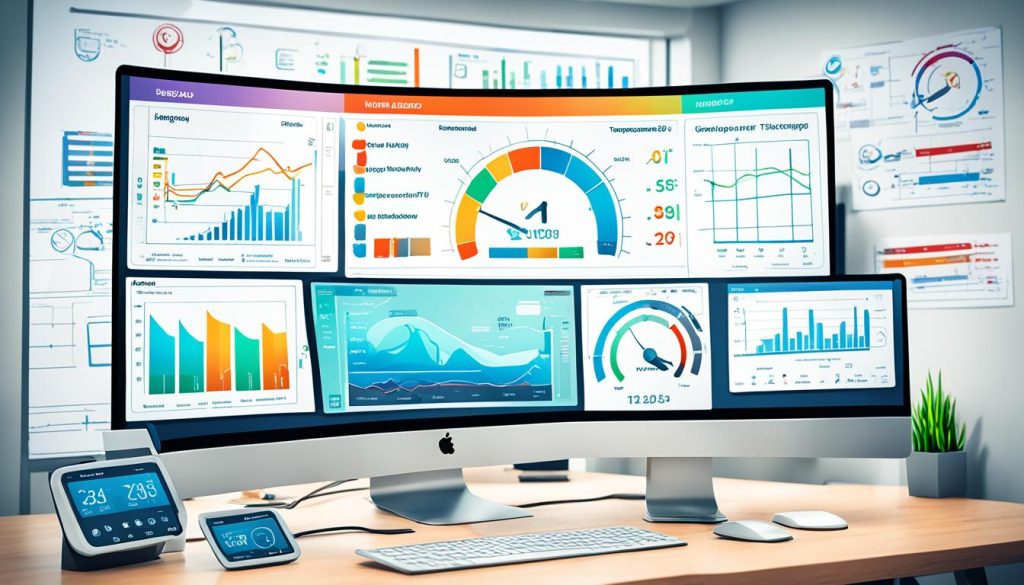Creating impressive HVAC reports is easy with heat load calculation software. This tool boosts accuracy and efficiency in your HVAC designs. It simplifies load analysis and energy modeling, helping you make professional reports that follow industry standards.
Heat load calculation software is a game-changer for HVAC pros. It lets you do detailed load analyses and get accurate system sizing recommendations. You can also make reports for clients, contractors, and regulatory bodies. Using these tools, you can make your HVAC design process better and give more precise and reliable results.
With web-based solutions like Cool Calc, you can use heat load calculation tools from any device with internet. This means you can work on projects from anywhere, team up with others, and link your calculations with other HVAC design apps. Learning these software tools helps you make HVAC reports that show your skills and add value to your clients.
Understanding the Importance of Heat Load Calculations in HVAC Design
Heat load calculations are key in HVAC design. They help make indoor spaces efficient and comfortable. Let’s see why these calculations are vital for your HVAC projects.
The role of heat load calculations in system sizing
Getting the right HVAC system size is all about precise heat load calculations. These figures tell you the correct equipment capacity for a building. They take into account insulation, windows, and how many people will use the space. This way, you can prevent your HVAC system from being too big or too small.
Impact on energy efficiency and comfort
Doing a thorough load analysis impacts energy efficiency and comfort. A system sized right uses less energy and cuts costs. It keeps temperatures steady, making the space comfortable for everyone.
Meeting building code requirements
Heat load calculations are key for following building codes. Many places need detailed load analyses for permits. Using ACCA-approved software helps make sure your calculations are up to standard and follow local laws.
| Aspect | Importance |
|---|---|
| System Sizing | Prevents over/undersizing, optimizes performance |
| Energy Efficiency | Reduces operating costs, minimizes environmental impact |
| Comfort | Ensures consistent temperatures, improves air quality |
| Code Compliance | Meets regulatory requirements, facilitates approvals |
Putting a focus on accurate heat load calculations leads to HVAC systems that work well. They offer comfort, save energy, and meet codes. This means happy clients and successful projects.
Key Features of Advanced Heat Load Calculation Software
Advanced heat load calculation software changes how we size and design HVAC systems. It has many features that make cooling load calculations easier and improve how accurately buildings are simulated.
These tools work with mapping services to quickly trace buildings. This means you can instantly calculate wall, ceiling, and floor areas. It saves time and makes HVAC sizing more precise.
Energy modeling is a key part of these tools. It predicts how much energy a building will use. This helps design more efficient HVAC systems.
Some software can create ACCA-approved Manual J and D reports. This is great for meeting industry standards and for showing clients your work.
| Feature | Benefit |
|---|---|
| Integration with mapping services | Quick building tracing and area calculations |
| Energy modeling | Improved energy efficiency predictions |
| ACCA-approved reports | Regulatory compliance and professional presentations |
| Rapid load and duct design | Efficient HVAC sizing for large homes |
With these features, you can quickly do cooling load calculations and HVAC sizing for big homes (5,000-15,000 sq ft). This means you can work on more projects and give your clients fast, accurate results.
Selecting the Right Heat Load Calculation Software for Your Needs
Choosing the best heat load calculation software is key for HVAC pros. The right tool makes your work easier and more accurate. Let’s look at what to think about when picking one.
Comparison of Popular Software Options
Several top HVAC software options are out there. ACCA-approved ones like Elite, Wrightsoft, and Nitek are great for heat load calculations. Each has its own strengths, so pick the one that fits your needs best.
| Software | Key Features | Pricing Model |
|---|---|---|
| Elite | User-friendly interface, comprehensive reporting | Subscription-based |
| Wrightsoft | Advanced modeling, integration with CAD | One-time purchase + updates |
| Nitek | Cloud-based, mobile accessibility | Tiered pricing |
Factors to Consider When Choosing Software
Think about how easy it is to use, if you can access it on your phone, and how it makes reports. Decide if you need basic or advanced features. Lennox dealers might want software that works well with LennoxPros.
Integration Capabilities with Other HVAC Design Tools
How well software works with other tools is important. Look for software that connects easily with CAD or energy modeling tools. This can make your design process faster and less prone to mistakes.
Create HVAC Reports with Heat Load Calculation Tools
Heat load calculation tools change how we make HVAC reports. They make creating detailed HVAC design reports easier. With these tools, you can make reports that look professional and meet what clients want.

Many tools let you do unlimited load calculations for free. You can try out different designs without spending money. For more detailed reports, some tools offer to make official ACCA Manual J reports for a fee.
Using these tools for HVAC reports has a big plus: customization. You can make reports for different people, like:
- Clients who want simple overviews
- Contractors needing detailed specs
- Groups that want to see everything is up to code
These tools boost your ability to make great HVAC reports. They do precise calculations and let you organize your info well. This mix of accuracy and style makes these tools a must-have for HVAC pros today.
Step-by-Step Guide to Performing a Heat Load Calculation
Learning how to do a heat load calculation is key for designing HVAC systems right. This guide will walk you through the steps. It uses advanced software tools for precise calculations.
Gathering Building Information and Data Inputs
First, collect important building details for your HVAC system. You’ll need:
- Building dimensions and orientation
- Wall, ceiling, and floor areas
- Window sizes and types
- Insulation values
- Occupancy patterns
Some software can get this info from Google Maps for buildings you already know. This makes the process easier.
Entering Data into the Software
Put the info you’ve gathered into your chosen software for heat load calculation. Make sure to fill in all needed fields correctly. This helps avoid mistakes in the final results.
Running Calculations and Analyzing Results
After you’ve entered all the data, start the load calculation. The software will work through the info and give you detailed results. Look over these carefully, paying attention to things like:
| Factor | Importance |
|---|---|
| Peak cooling loads | Determines maximum cooling capacity needed |
| Heating requirements | Guides heating system sizing |
| Room-by-room loads | Helps in zoning and duct design |
| Seasonal energy use | Aids in energy efficiency planning |
By following these steps, you’ll have a strong plan for an HVAC system that’s efficient and comfortable. It will meet the building’s unique needs.
Interpreting Heat Load Calculation Results for HVAC System Design
Understanding heat load calculations is key in designing an efficient HVAC system. These results help create a system that keeps you comfortable. Let’s explore how to interpret these calculations for your HVAC system.
First, look at the software output for HVAC load calculations. You’ll see the total heating and cooling loads, and how each room contributes. This detail is vital for a balanced system throughout the building.

When sizing your HVAC system, focus on the peak load. This is the highest demand your system will face. Choose equipment that can handle this load without being too big, which can cause inefficiency and comfort problems.
Here are important points to consider when looking at your results:
- Total building load
- Individual room loads
- Sensible and latent heat ratios
- Peak load timing
- Safety factors
Using ACCA-approved software gives you reliable results for your HVAC design. These tools make it easier to understand your data with charts and graphs. They show load distribution across zones or at different times.
| Load Type | Interpretation | Impact on Design |
|---|---|---|
| Sensible Heat | Affects dry-bulb temperature | Influences equipment capacity selection |
| Latent Heat | Relates to humidity control | Determines dehumidification needs |
| Peak Load | Maximum system demand | Sets minimum equipment size |
Getting accurate load calculations is crucial for a good HVAC design. It ensures your system meets your comfort needs and saves energy. Take the time to analyze your results for a well-designed HVAC solution.
Customizing HVAC Reports for Different Stakeholders
Customizing HVAC reports is key for good communication with various stakeholders. By making reports specific to each group, you make sure they get the info they need in a way they can understand and use.
Tailoring Reports for Clients
For clients, focus on how your HVAC work makes them more comfortable and saves money. Talk about energy savings, better air quality, and lower costs. Use easy language and pictures to explain tough ideas.
Creating Technical Reports for Contractors
Reports for contractors need lots of technical details. Include system specs, how to install it, and how well it performs. Use terms contractors know and give detailed diagrams for clear setup of the HVAC system.
Generating Compliance Reports for Regulatory Bodies
Reports for regulatory bodies must show you follow the rules. They need all the info to prove you’re meeting standards. Be very detailed and use the right formats as required by the rules.
| Stakeholder | Key Report Elements | Focus Areas |
|---|---|---|
| Clients | Comfort metrics, efficiency data | Cost savings, environmental impact |
| Contractors | Technical specifications, installation guides | System performance, maintenance requirements |
| Regulatory Bodies | Compliance documentation, test results | Safety standards, energy efficiency ratings |
Customizing HVAC reports for each group improves communication and helps projects succeed. Use the right software to make reports faster and keep them consistent across all types.
Enhancing Report Visuals with Charts, Graphs, and Diagrams
HVAC report visualization is key to sharing complex info with clients and stakeholders. Using charts, graphs, and diagrams turns data into visuals that are easy to understand. This makes it easier for people to make decisions.
Presenting data in HVAC reports is more than just making it look good. It points out important findings and trends that might be missed in text-only reports. When making HVAC design graphics, think about these elements:
- Load distribution charts
- Energy consumption graphs
- System performance diagrams
- Temperature and humidity maps
- Airflow schematics
Using these visuals can make your HVAC reports more impactful. Many software packages for heat load calculations have built-in tools for creating professional graphics. This means you don’t need a lot of design skills.
When picking visuals for your reports, focus on making them clear and relevant. Use charts that fit your data and what your audience likes. For instance, bar charts are great for comparing values, line graphs for showing trends, and pie charts for showing parts of a whole.
| Visual Element | Best Used For | Example in HVAC Reports |
|---|---|---|
| Bar Charts | Comparing values | Room-by-room heat load comparison |
| Line Graphs | Showing trends | Energy consumption over time |
| Pie Charts | Displaying proportions | Distribution of heating/cooling sources |
| Heat Maps | Spatial data representation | Temperature variation across building zones |
By adding these visuals, you can make HVAC reports more engaging and informative. This helps share your findings and advice clearly with clients and stakeholders.
Incorporating Energy Modeling into HVAC Reports
Energy modeling changes the game for HVAC design. It lets you see how your system will work over time. This helps make HVAC systems more energy-efficient. By adding HVAC energy modeling to your reports, you give clients important info on saving energy and helping the environment.
Benefits of energy modeling in HVAC design
HVAC energy modeling has many benefits. It improves system performance, cuts costs, and helps meet green goals. With precise energy analysis, you can pick the best design for your clients.
Software tools for energy modeling
Now, many tools for calculating heat loads also model energy use. Popular software for this includes EnergyPlus, eQUEST, and IES Virtual Environment. These tools let you simulate energy use and test different HVAC setups.
Integrating energy modeling results into reports
When you add energy modeling to HVAC reports, highlight important data like annual energy use and potential savings. Use charts and graphs to make these easy to understand. Showing the long-term benefits of energy-efficient HVAC design makes your reports more convincing.





0 Comments